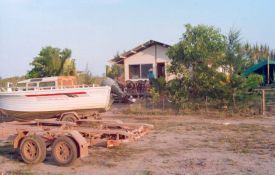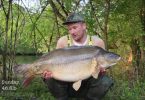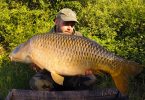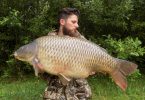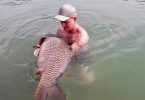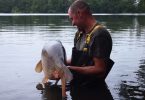You may remember that the last time I wrote in these pages I told you that I was heading off to Australia in November 2001. This trip was primarily to visit one of my best friends his wife and two son’s, one of which is my godson, who live in Melbourne. My friend emigrated to Australia twelve years ago, and I try to get over to see him every two to three years.
Over the past few visits I have also managed to incorporate some great fishing trips, both to the tropical northern regions, such as the Northern Territory and Queensland, fishing for barramundi, giant trevally, queen- fish and many other hard fighting tropical spices, and I have also tried my hand at fly fishing for trout in Tasmania, along with dropping a line off the piers and jetty’s of Melbourne’s Port Phillip Bay for what ever comes along.
On this occasion I was going for five weeks, which gave me scope for a 4-5 day fishing trip to fit in with staying with my friends in Victoria and also doing some sightseeing, which also involved some trout fishing as it turned out, but more of that latter. So back in December 2000 I emailed my friends at Angling Adventures, a company who specialise in angling holidays in Australia and the pacific region. I have always used them when I have fished in the NT & Queensland, and they have sent me to great locations, both angling and scenic. I had checked out their website, and picked out 3-4 different venues, all of which looked good, but I thought the best person to decide which place to go for would be Gary Barmby the owner of the company, who along with his colleague Glenn ‘Barra Mac’ McCarthy personally fish ever operation they send clients to. The reply to my email arrived back in a few days, saying that the best venue for the time of year that I was fishing would definitely be Jarbu Lodge on Croker Is. This location is in Arnhem Land, Aboriginal Territory, which means it, can only be accessed by obtaining a permit. The lodge had also only been open for 2-3 seasons, and the fishing area was immense and varied, which meant that I would be fishing almost virgin territory and the fish would not be hook shy. So I booked the trip, and waited for November 2001 to come round…
Heathrow, midday 30th October 2001, at last my holiday had arrived, five weeks of Australian sunshine, seeing my friends and hooking into some rod bending fish. My flight took around 20 hours, with just a very short break at Singapore to change planes. Tony, my mate for over 40 years was there at the airport to pick me up on the evening of the 31st.
To tell the truth I had got my timings for this trip slightly wrong as I was due to fly up to Darwin on Sunday the 4th November and I also had to go to see Glenn at Angling Adventures on the 2nd to have a chat about Croker Is, also to meet the fellow angler who I would be fishing with, and to buy some gear, line, lures etc from their local tackle shop. I should have allowed myself a few more days to get over the jetlag.
On Sunday afternoon I was heading back to the airport loaded up with fishing tackle. For this trip I was using my G.Lomas GL3 rod along with a Shimano chronarch baitcaster reel, I was also taking another lighter spinning rod with a fixed spool reel just as back up. On the baitcaster I was using 10kg braid and on the fixed spool 4kg braid, I also had a small selection of lures, plugs and spinners, the lodge would provide most of the lures we would be using. The flight took around six hours as I had to take a connecting flight from Sydney which was delayed.
I checked in at my Darwin hotel just before midnight, not ideal as we had to catch a light plane the next morning to take us over to Croker Is.
After a good nights sleep I meet my fellow angler, Russell Paatsch at Darwin’s light aircraft terminal, ready for our one-hour flight, Croker Is lies to the north east of Darwin just off the Cobourg peninsula in the Arafura Sea. As we approached the island I looked out of the cabin window, taking in the spectacular view of the many bays, coves and mangrove creeks lying below in the pale blue sea.

On our arrival, the wife of our host, Katie Butler, met us and drove us the short distance to the camp, which would be our home for the next five days. The lodge consists of one large wooden building used for cooking and eating, the sleeping quarters are provided for by three large tents, which can sleep two people comfortably, along with shower and toilet facilities in a separate building. After freshening up Russell and I, took a walk along the beach, as the tide was out, and it would be a couple of hours before Lance Butler, our Aboriginal guide, and operator of the Jarbu camp, could launch his boat. While Russell and I walked along the beach we noticed several large outcrops of rock lying out on the mud flats, and also some closer to shore, these reefs were shortly to provide us with our first barramundi encounters.
 Just after 3pm the tide had come in far enough for Lance to launch his boat. Lance has been a fishing guide for nearly twenty years, and he knew exactly where the barra would be. We only had to travel a short distance from the camp to one of the reefs that Russell and I had seen earlier. Lance anchored the boat around 30-35 meters from the rocks, and rigged both of us up with shallow diving lures. He told us where to cast into the gaps in the reef, but said to be careful on the retrieve, as it was very easy to snag the rocks. I have had some experience of barra fishing before, but this was the first time I had fished for them casting to a reef, and for Russell, although he does a lot of sea fishing off the coast of Victoria, this was his first go at barramundi. I expect you can guess what happened, for the first 10 minutes or so Russell and I spent most of the time hooking into rocks rather than fish! Lance soon rigged up his own rod, and showed us how it was done. After two or three casts he had a barra in the boat, and after some tuition from Lance, Russell and I both started to hook up. The barra were not large, around 5-7lbs but they put up a tremendous fight, and extracting them from the rocky terrain proved a real challenge. So it proved when I hooked into a much bigger fish which tore off with my lure, taking around 30 meters of line off my reel in a few seconds. I thought I had got control of the fish, but then it went into the reef, and that was the end of that. At the end of that short session we had landed around a dozen or so barramundi, along with some blue salmon and a couple of catfish, and we had easily lost a similar number due to our inexperience.
Just after 3pm the tide had come in far enough for Lance to launch his boat. Lance has been a fishing guide for nearly twenty years, and he knew exactly where the barra would be. We only had to travel a short distance from the camp to one of the reefs that Russell and I had seen earlier. Lance anchored the boat around 30-35 meters from the rocks, and rigged both of us up with shallow diving lures. He told us where to cast into the gaps in the reef, but said to be careful on the retrieve, as it was very easy to snag the rocks. I have had some experience of barra fishing before, but this was the first time I had fished for them casting to a reef, and for Russell, although he does a lot of sea fishing off the coast of Victoria, this was his first go at barramundi. I expect you can guess what happened, for the first 10 minutes or so Russell and I spent most of the time hooking into rocks rather than fish! Lance soon rigged up his own rod, and showed us how it was done. After two or three casts he had a barra in the boat, and after some tuition from Lance, Russell and I both started to hook up. The barra were not large, around 5-7lbs but they put up a tremendous fight, and extracting them from the rocky terrain proved a real challenge. So it proved when I hooked into a much bigger fish which tore off with my lure, taking around 30 meters of line off my reel in a few seconds. I thought I had got control of the fish, but then it went into the reef, and that was the end of that. At the end of that short session we had landed around a dozen or so barramundi, along with some blue salmon and a couple of catfish, and we had easily lost a similar number due to our inexperience.

The next day was our first full days fishing and after and early breakfast we set off in Lance’s 6 meter ‘Ocean River’ boat to explore some of the mangrove creeks that he had told us about over dinner the previous evening. After travelling for about 20-30 minutes we anchored up at the mouth of a creek, when fishing these mangrove creeks catching the right time of the tide is usually vitally important, the best times tend to be when the tide starts to run out and again when it returns, these of course will very from area to area and from day to day. Lance had got it spot on, the tide in this creek had just started to run out, and as the water drained out of the mangroves it concentrated the fish into the channel. My first few cast brought a 5lb barra to the boat, a couple of casts later I hooked into a much larger fish, only about 10ft from our mooring, and again I lost it as it dived under the boat, and snagged my lure on a mangrove root. The next hour and a half brought some hectic action with all three of us hooking up every other cast, and Lance working overtime releasing the fish as they arrived at the boat. This task was made easier as we were fishing with barb less hooks, both to avoid damage to the fish, and to the anglers! I lost count of the number of fish we caught, and lost! But it must have been between 50-60, the majority being barramundi along with a fair portion of blue salmon and a few small GT’s, queenfish, cod (not the same as our Atlantic cod) and catfish. In the afternoon the action slowed, and we returned to the lodge around 5pm ready for a warm shower, and a couple of cold beers, followed by a great fresh barramundi dinner cooked by Katie!
The next morning saw us heading for Raffles Bay, this is also the location of a commercial pearl farm, so Lance radioed ahead to let them know we were coming to fish (we didn’t want them to think we were pirates!) On the way over we stopped to troll around a reef for giant trevally and queenfish, which brought the biggest fish of the trip so far to the boat, 4-5 fish of around 10-12 lbs. We then anchored up at the mouth of another creek, and again had good sport with the local barra, blue salmon, cod and queenfish. In the afternoon we tried several other creeks, which produced some mangrove jacks and a few small snapper. The sizes of the fish further down the mangrove channels tended to be smaller than the ones at the creek mouths, the reason for this I think is that the mangroves act as a nursery area for a vast verity of spices, and as the fish grow and mature they start to move out into the more open waters. But you still can’t be sure what will grab your lure, it could be 10 inch jack or a 40lb barra!
 On Thursday Lance decided that he would take us to Cape Croker to fish for some big GT’s, queenfish and spanish mackerel that inhabit the reefs at the tip of the island. The journey took over an hour, and when we arrived Lance set us up with some serious sea tackle, as the fish we could expect to encounter here could run up to 60-70lb’s if we were lucky. We were soon hooking into some good GT’s and queenfish of around 16-18lb’s, Russell and I also caught mackerel, barracuda, and a coral trout, these last three were all new spices that I added to my list on this trip. In the afternoon we were back in the mangrove systems close to the Cape, the creek we fished was a large one with plenty of fallen trees, stumps and adjoining smaller channels. Here we had some great sport with the barramundi especially at the mouth of the creek, we were often getting triple hook ups, which made life exciting. As we moved further down the channel it started to narrow, and we then began to catch more mangrove jacks and cod. As we passed each snag we would all have 2-3 casts at it, if no-one was at home we just moved on to the next one. On some of these snags you could take 4-5 fish each in 7-8 minutes! I lost count of how many fish we boated but it must have been nearly 70. On the way back to the lodge we again tried our luck on the reef, but the tide had turned, and there was not much action.
On Thursday Lance decided that he would take us to Cape Croker to fish for some big GT’s, queenfish and spanish mackerel that inhabit the reefs at the tip of the island. The journey took over an hour, and when we arrived Lance set us up with some serious sea tackle, as the fish we could expect to encounter here could run up to 60-70lb’s if we were lucky. We were soon hooking into some good GT’s and queenfish of around 16-18lb’s, Russell and I also caught mackerel, barracuda, and a coral trout, these last three were all new spices that I added to my list on this trip. In the afternoon we were back in the mangrove systems close to the Cape, the creek we fished was a large one with plenty of fallen trees, stumps and adjoining smaller channels. Here we had some great sport with the barramundi especially at the mouth of the creek, we were often getting triple hook ups, which made life exciting. As we moved further down the channel it started to narrow, and we then began to catch more mangrove jacks and cod. As we passed each snag we would all have 2-3 casts at it, if no-one was at home we just moved on to the next one. On some of these snags you could take 4-5 fish each in 7-8 minutes! I lost count of how many fish we boated but it must have been nearly 70. On the way back to the lodge we again tried our luck on the reef, but the tide had turned, and there was not much action.
The next day was my last at Jarbu, I had to catch a flight at 1pm back to Darwin for my evening connection to Melbourne. Which meant that we could not travel very far from the lodge that morning, so we again tried our luck fishing the many rocky outcrops and reefs that were close to the camp. I think this became my favourite form of fishing on this trip, because your casting had to be accurate, and all so your technique on the retrieve of the lure had to be just right, otherwise you would constantly be hooking into rocks. But over the days I had steadily improved my accuracy of cast, and also my retrieval technique. We all had a good mornings sport with barramundi and blue salmon the two main spices caught along with the odd cod and catfish. As midday came around Lance dropped me off at the lodge, Russell was not going back until the next day, so they were going to head off to another one of Lances favourite spots that afternoon. I must admit I felt very envious of them as I turned and walked up the beach to the lodge, and they headed off for some more rod bending action!
This had been a great trip I am not sure how many fish I landed exactly, because at times the action was so furious there was no time to count them! But I would imagine it to be between 80-90, with many other fish lost. Also I had managed to add 4-5 new species to my catch list. This is a venue I plan to return to in the next few years!

Earlier in this piece I mentioned that I managed to get in some trout fishing. This happened on the last weekend of my trip, I had wanted to visit Victoria’s High Country for some time, so my mate, Tony and I hired a car for a long weekend. We decided to travel along the Great Alpine Road that runs from Bairnesdale which lies around three hours drive to the east of Melbourne up to Wangaratta, close to the NSW border. We set off late on Friday afternoon, and arrived in Bairnesdale at around 8.30. After a good nights sleep at a small motel we set off early the next morning, the weather was perfect, bright sunshine in a beautiful blue sky. We had brought a variety clothes with us from shorts & tee shirts to wet weather gear, as we would be heading up to altitudes of around 1600-1700 meters, and the weather in these regions can be quiet changeable.
Before I set off on this trip I had paid a visit to a local tackle shop, just to get an idea to what lures/spinners I would be likely to need. They told me that the trout, rainbow’s, brook’s and brown’s that I would probable encounter would not be very large, and that I should use small profile spinners.
 As we travelled further into the foothills of the Great Dividing Range we started to encounter some rivers. We pulled up at a couple of these, and I tried a few cast at some likely spots, but with no luck. For our second night we had booked into motel at the small town of Tawonga in the Kewia River Valley, we arrived there in middle of the afternoon. Here I asked a couple of the locals about the fishing prospects, and they gave me two or three options. The first was to try the large Rocky Valley Dam, which is the water supply for a hydro-electric scheme, the second was the local pondage, a small shallow lake in the centre of the town of Mount Beauty, just a short distance from where we staying, and the third option was the Kiewa River. We decided to head up to the Rocky Valley dam first, this stand’s at an altitude of around 1500-1600 meters. When we arrived, it was blowing a gale, time to put on some warmer gear! I tried my luck at several points around the dam, but with no luck, so after 45 minutes we headed back to have a go at the pondage. While Tony found a spot to park the car, I took my rod, and strolled around the lake. I didn’t need to go far before I noticed some trout feeding on the evening hatch of fly’s. My first cast was followed by 3-4 small fish, this was encouraging, a couple of casts later I hooked into my first fish. It was only a small brook trout, but it fought quiet well, five other fish followed in quick succession. But with the light fading, and Tony wanting to get back to town for a meal, I called it a day.
As we travelled further into the foothills of the Great Dividing Range we started to encounter some rivers. We pulled up at a couple of these, and I tried a few cast at some likely spots, but with no luck. For our second night we had booked into motel at the small town of Tawonga in the Kewia River Valley, we arrived there in middle of the afternoon. Here I asked a couple of the locals about the fishing prospects, and they gave me two or three options. The first was to try the large Rocky Valley Dam, which is the water supply for a hydro-electric scheme, the second was the local pondage, a small shallow lake in the centre of the town of Mount Beauty, just a short distance from where we staying, and the third option was the Kiewa River. We decided to head up to the Rocky Valley dam first, this stand’s at an altitude of around 1500-1600 meters. When we arrived, it was blowing a gale, time to put on some warmer gear! I tried my luck at several points around the dam, but with no luck, so after 45 minutes we headed back to have a go at the pondage. While Tony found a spot to park the car, I took my rod, and strolled around the lake. I didn’t need to go far before I noticed some trout feeding on the evening hatch of fly’s. My first cast was followed by 3-4 small fish, this was encouraging, a couple of casts later I hooked into my first fish. It was only a small brook trout, but it fought quiet well, five other fish followed in quick succession. But with the light fading, and Tony wanting to get back to town for a meal, I called it a day.
I did try again the next morning, but with no luck. That concluded my fishing for this trip. But I am already looking forward to my next visit to OZ in 2003, where I hope to go on a trip to Papua New Guinea, to fish the might Bensbach River, where I am told that catches of Barramundi can run into the hundreds!!
Article by: Bryan Garnett – 2002

